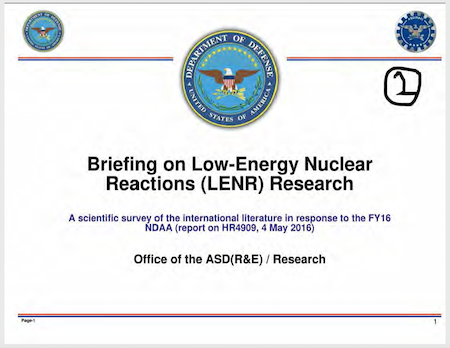Nuclear-Powered Undersea Swarms
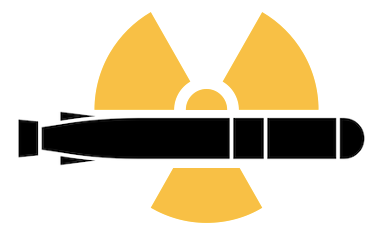
KEY JUDGMENTS:
▶︎ Two key drivers of China's undersea weapons development are the convergence of torpedoes, mines, and autonomous underwater vehicles (AUVs), and a desire for an underwater swarming capability to augment offensive mine warfare.
▶︎ Chinese scientists are actively seeking ways to overcome AUV endurance and range limitations in order to enable missions such as persistent, wide area ISR (Intelligence, Surveillance, and Reconnaissance), and standoff attack.
▶︎ Chinese scientists are exploring the use of nuclear energy as a power source for conventionally armed torpedoes, and recently published a conceptual design for a small nuclear reactor intended to power a standard (533mm or 21 inch) diameter torpedo.
▶︎ While the endurance and range of a nuclear-powered torpedo would provide China with a significant operational advantage, attendant technological challenges, such as communication and navigation, would need to be addressed before such weapons could be deployed over long distances.
▶︎ Given the current scale of nuclear microreactors, it is highly unlikely that China will develop and operationalize a nuclear-powered standard torpedo within the next ten years.
▶︎ While a nuclear-powered standard torpedo may be beyond China's technical capability, novel methods of energy production are either currently available or under development, making it increasingly likely that China will develop high-endurance, long-range AUVs within the next ten years.
▶︎ If China successfully overcomes AUV energy limitations, this will dramatically enhance the People's Liberation Army Navy (PLAN) mine warfare capability, enabling it to threaten U.S. maritime forces in home waters, as well as beyond the littorals in deep ocean regions.
On July 20, 2022, the South China Morning Post (SCMP) published an article claiming that Chinese scientists had "completed the conceptual design" of a small nuclear reactor to power a standard (533mm/21 inch) heavyweight torpedo, what the article describes as a "mini version of the Russian Poseidon unmanned submarine" (a reference to the Russian development of a nuclear-armed, nuclear-powered torpedo/AUV). The SCMP article made several claims regarding the design and capabilities of the reactor, as well as operational concepts for a nuclear-powered standard torpedo, including:
-
The weapon's reactor would provide the necessary power for transiting the long distance to the target location. The reactor would then be jettisoned, with stored energy from onboard batteries providing power during the attack phase of the mission.
-
A combination of low-cost materials and the omission of radiation shielding would enable large-scale production.
-
The reactor would generate in excess of 1.4 megawatts using approximately 4 kilograms (8.8 pounds) of uranium.
-
The reactor could propel the torpedo at a sustained speed of 30 knots for 200 hrs. (The article also states that the reactor could operate for up to 400 hours and enable a range in excess of 10,000 kilometers.)
-
The torpedo would make use of artificial intelligence to engage targets with little or no human intervention.
-
Nuclear-powered, AI-enabled torpedoes could strike enemy submarines as they leave port in home waters.
-
Guo Jian, a scientist with the China Institute of Atomic Energy, and lead author of "Concept of a Nuclear Reactor Power Supply for Unmanned Underwater Vehicles," which inspired the SCMP article, is quoted as saying that, "there is a growing demand in China for small, high-speed, long-range unmanned underwater vehicles that can be used in reconnaissance, tracking attack, and strategic strike."
The SCMP article references two scientific papers published in the Journal of Unmanned Undersea Systems, a publication of the China State Shipbuilding Corporation. An overview of each paper and an analysis follows.
NOTE: English translation was obtained by importing the text of the papers into Google Docs and using the "Translate Document" tool. Any resulting translation errors or distortions could contribute to erroneous conclusions.
▶︎ Concept of a Nuclear Reactor Power Supply for Unmanned Underwater Vehicles
Journal of Unmanned Undersea Systems (JUUS)
July, 2022
Guo Jian, Yu Rongjun, An Weijian, Wang Ao, Li Gao, Jian Xiaohui
Affiliation: China Institute of Atomic Energy, Beijing
SUMMARY:
The Guo paper presents a conceptual design for a miniaturized, water-cooled, thermal-neutron nuclear reactor that can be used to power a standard 533mm diameter heavyweight torpedo.
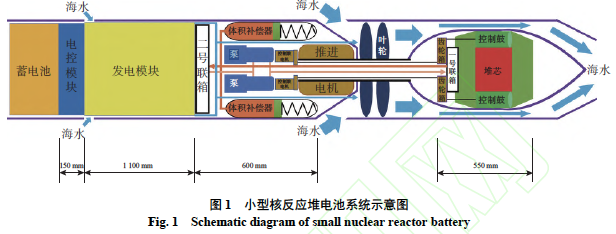
CLAIMS:
-
The nuclear power system would consist of a water-cooled reactor and thermoelectric power generation technologies.
-
The reactor system would not exceed 3 meters in length, 533mm in diameter, or a net weight of 750kg, making it compatible with a standard heavyweight torpedo, and therefore capable of being launched from standard torpedo tubes.
-
The nuclear fuel would be uranium-235.
-
The "clean nuclear reactor power supply" would be activated by the onboard battery system after the weapon is released "to protect personnel."
-
The nuclear reaction would enable a sustained speed of 30 knots for 200 hours, providing a range of "tens of thousands of kilometers," with greater range/endurance possible at lower power usage levels. The onboard battery system could be combined with the reactor to provide short bursts of high speed.
-
The reactor could, in theory, operate up to 400 hours at the rated operating temperature of 300°C, but 200 hours is a "reasonable" assumption. (This is likely the source of the SCMP article's conflicting claims.)
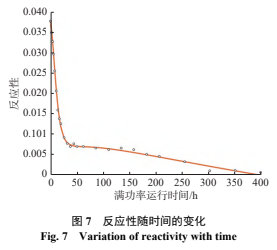
-
There is no specific claim regarding the reactor being jettisoned prior to the torpedo attacking its target, as claimed in the SCMP article. The only language addressing this is: "[The] nuclear reactor is placed at the rear end of the hull, so that the nuclear reactor compartment can be jettisoned if necessary, and the propulsion motor is powered entirely by the battery. Abandoned nuclear reactors should ensure reliable shutdown."
-
The article focuses on the extended range capability of a conventional torpedo, and does not address the torpedo's potential for undersea swarming.
▶︎ Discussion on Intelligent Decision-making Requirements and Methods for Underwater Unmanned Vehicle Torpedo Attack
Journal of Unmanned Undersea Systems
July, 2022
Ma Liang, Guo Liqiang, Zhang Hui, Yang Jing, Liu Jian
Affiliation: Navy Submarine Academy, Qingdao
SUMMARY:
The Ma paper highlights current Chinese thinking on the development and employment of AUV swarms ("UUVcluster," ""cluster operations") in "intelligent strike" missions, with a particular emphasis on "torpedo attack decision making," as "[this] ... is the premise and basis for unmanned equipment to form self-organized cross-domain coordination, autonomous cluster confrontation and other combat capabilities."
CLAIMS:
(Quoted in their entirety.)
-
"The autonomous technology of unmanned equipment is the most dynamic frontier technology field at present, and improving the intelligence of decision-making is an inevitable trend in the development of underwater unmanned vehicles."
-
"UUVCluster use and integrated use with underwater manned platforms can effectively control the underwater space in important areas such as nearshore, offshore and source areas."
-
"In the source sea area that is difficult for manned platforms to reach, strikes are carried out on submarines leaving the port. UUVs can form a mobile underwater unmanned swarm, and sail to the vicinity of the opponent's port base according to the planned route."
-
"UUV grouping can use satellite communication through underwater acoustic communication or covert floating to carry out autonomous multi-directional attack on the target according to the command of command UUV or shore-based command center."
-
"[An AUV swarm can] conduct concealed standby or mobile search in offshore waters where submarine activities are intensive, and wait for an opportunity to raid or guide other forces to strike remotely."
-
"In the vicinity of the important channel where it is known that the opponent may maneuver, the mother boat will pre-deploy a plurality of UUVs on the channel to dormant standby or maneuver search at designated array points on the channel. UUVs can cruise at a low speed at a certain depth, regularly float for positioning, transmit information and receive instructions, and can also search and detect autonomously according to the planned route. After the target is found, the audible command can be used to attack autonomously, and it can also carry out fire strikes through information transmission, guiding mother boats or other underwater forces."
-
"In the coastal waters and underwater fixed monitoring equipment, [UUVs can] perform normalized vigilance tasks for important port bases and waters around the waterway, and enhance the defense and combat capabilities of the coastal waters."
-
"Multiple UUVs can be used for long-duration underwater autonomous patrols, forming a mobile detection network with fixed underwater monitoring equipment, forming a threat denial area with a certain width and depth, attacking or effectively delaying enemy underwater forces."
-
"In order to ensure the effective realization of UUV's decision-making function for submarine torpedo attack, it is necessary to focus on solving the following key problems:
-
Data fusion processing in complex environments - Situational awareness is a must-have capability for UUVs. However, in unknown and complex underwater battlefields, the observation and interaction of multi-source information exist in the Noise and Errors. Therefore, in the absence of manual intervention, how to extract features from multi-source heterogeneous complex data such as underwater sound, image, temperature, etc., achieve consistent representation and fusion of information, and solve for battlefield situational awareness and subsequent target motion elements, etc. Providing necessary support in the link is a prerequisite and a top problem that affects whether the torpedo attack decision can be realized.
-
"Optimal solution problem under uncertain and confrontational conditions - The decision-making process of UUV attack on submarine torpedo is a typical dynamic, multi-constrained, nonlinear complex system, which is affected by the uncertainty of the hydrological conditions in the sea area, the confrontation and equipment of the game behavior of the enemy and the enemy['s] own performance characteristics. In this complex system, the temporal evolution of each entity state and element will have an impact on the optimization results, such as the spread of targets, countermeasures, and torpedo tactical performance. When estimating the hit probability of torpedo, if the traditional analytical method and simulation method are still used, then with the increase of parameter dimension and search space, the solution will be time-consuming or even the solution space will not converge, which needs to be considered.
-
"Fast and efficient decision-making under time-sensitive tasks - The core of autonomy is decision-making, and the pursuit of preemptive 'speed' is the key. UUV torpedo attack is a covert and sudden mission action. The launch platform needs to make quick and accurate decisions through limited observation information to achieve the purpose of surprising victory. At present, the decision-making methods commonly used by manned platforms, such as fuzzy logic, Fan's reasoning, and Bayesian network, etc., often restrict each other's execution efficiency and credibility, and it is difficult to meet the real-time requirements of UUVs for submarine assault missions to torpedo attack decision-making."
-
"Decision-making trust problem - [O]n the issue of UUV torpedo attack decision-making, it is a very serious matter to hand over the authority to the autonomous weapon system, and it is necessary to ensure the accuracy and trustworthiness of the autonomous decision-making results."
-
-
"Most of the existing torpedo attack decision-making relies on the combat simulation technology, establishes the task behavior model of various entities through rules, and conducts optimization analysis and decision-making on the basis of the simulation results. On the one hand, the simulation decision-making method oriented by optimizing the objective function has high requirements on the completeness of battlefield time series data and environmental information, and lacks the autonomous ability to dynamically adjust the decision-making scheme in the unknown and complex sea area. On the other hand, this pure conditional judgment method has limited ability to represent entity behavior, and with the increase of battlefield situation complexity, the computational workload increases exponentially, which is difficult to describe the complex task behavior of entity forces, resulting in modeling portability, extensibility, and reusability."
-
"At present, machine learning is in the stage of developing from 'perceptual intelligence' to 'cognitive intelligence.' Although it has been relatively mature in the processing of problems in the fields of data mining and pattern recognition, it is still relatively [im]mature in terms of knowledge expression, logical reasoning, etc. It is believed that the intelligent decision-making of UUV torpedo attack requires the joint action of combat simulation technology, heuristic optimization algorithm, and machine learning technology. By giving full play to the unique multi-modal data fusion and generalization adaptive capabilities of machine learning, it can be used to solve the above-mentioned key problems, [and] make up for the lack of dynamic and flexibility of traditional simulation decision-making methods, and jointly serve the development of equipment command and control systems and software."
ANALYSIS:
The convergence of torpedoes, AUVs, and sea mines is a key driver in the development of undersea weapons both in the United States as well as the People's Republic of China. It is clear to naval strategists of both nations that mobile, swarming mines would pose a serious operational dilemma for an adversary, and could potentially hold warships at risk in nearly any region of waterspace, not only in the littorals, but on the high seas as well. The latter was highlighted in the 2021 Asia-Pacific Regional Security Assessment published by the Institute for Strategic Studies, in a scenario involving the use of electrically-powered Yu-9 torpedoes acting as a swarm to attack a U.S. Navy carrier strike group in the Phillippine Sea. (Strikepod Systems provided research for the scenario.)
A breakthrough in AUV range and endurance would be key to advancing the development of undersea swarms, and the Guo paper's proposed nuclear-powered torpedo is indicative of what is likely a broader Chinese effort to overcome this limitation. While neither the Guo nor Ma papers refer to any organized Chinese effort to develop undersea swarms, they do indicate that Chinese scientists are willing to engage in "out of the box" thinking in pursuit of novel AUV energy solutions to enable this capability, and that Chinese naval strategists believe that such a capability would provide China with the means to significantly blunt enemy maritime power.
Based on a reading of these papers, we can conclude the following with respect to China's efforts to acquire an undersea swarming capability:
| ENERGY |
Chinese engineers are actively seeking ways to overcome the limitations of current AUV energy storage and power generation technologies in order to enable long-range, wide area, persistent autonomous underwater operations, including mobile, swarming minefields.
-
AUV endurance is currently driven by the size, quantity, and/or energy density of onboard energy storage, which is primarily in the form of lithium-ion batteries and, increasingly, fuel cell technology.
-
In general, endurance (and therefore range) increases with the size and displacement of the underwater vehicle. Larger vehicles - large displacement unmanned underwater vehicles (LDUUVs), and extra-large unmanned underwater vehicles (XLUUVs) - are capable of missions of weeks or months, whereas medium and small vehicles, such as those used for mine countermeasures, oceanographic survey, or ISR, are generally capable of missions lasting hours or days (with the notable exceptions being "floats" or underwater gliders, which, given their energy efficiency and buoyancy-driven propulsion, can deploy for weeks, months, or even years).
-
A mobile minefield comprised of high-endurance, larger displacement AUVs is also possible. However, this would entail much higher production costs, as well as greatly increased operational complexity given that larger vehicles would either be pier-launched, or require launching from vessels equipped with specialized launch and recovery systems. Smaller AUVs would be less expensive to develop and to operate, and could be deployed in far larger numbers from a wider range of launch platforms.
| INFORMATION TECHNOLOGY CHALLENGES |
Chinese scientists and engineers have identified and are working to overcome key data collection, processing, and transmission challenges related to undersea vehicle autonomy.
-
They recognize that AUVs will need to collect, process, and integrate a wide range of sensor data in order to enable effective situational awareness and mission-critical operations, and that artificial intelligence and machine language (AI/ML) technologies will be required to interpret this data given the complexity of the undersea operating environment and dynamics of undersea combat.
-
They recognize the challenges of acoustic communication - low bandwidth, attenuation, latency - and that these constraints will in turn dictate the nature and quantity of data that can be transmitted in the undersea environment.
-
They recognize the challenge of trust involved in human-machine teaming, and how this is particularly an issue in the undersea domain where weaponized vehicles will require autonomous operation over extended periods of time, with human operators "on the loop" rather than in it.
-
They believe AUV tactical operations and maneuvering, situation awareness, and path planning are areas of research and development that should receive immediate attention.
| THE TORPEDO |
Given the technological challenges involved in scaling down a uranium-fueled, water cooled nuclear reactor to fit inside of a 533mm diameter torpedo, it is highly unlikely that China could develop a working prototype, test, and operationalize a standard nuclear-powered torpedo within at least the next ten years.
-
For comparison, Russia's nuclear-powered, nuclear-armed torpedo/AUV, the Poseidon, has been (publicly) under development by Rubin Design Bureau for nearly eight years (and likely much longer).
-
The nature of Poseidon's nuclear power plant is a matter of speculation, but given the vehicle's dimensions (nearly four times the diameter and eight times the length of a standard heavyweight torpedo), it is possible that it could be powered by a system analogous to a microreactor or small modular reactor (SMR). While microreactor R&D is underway in several countries, including China, by both public and private entities, these reactors are at scales far larger than what could be accommodated within a 533mm diameter casing.
The U.S. Department of Defense's Project Pele, for example, seeks to develop portable nuclear reactors to power remote operations that can be transported via truck, aircraft, or train.
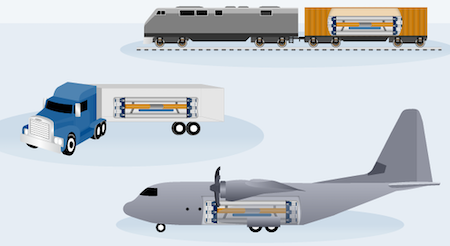
Source: Government Accountability Office (GAO)The NuScale SMR reactor casing is 19.8 meters (65 feet) long and 2.7 meters (9 feet) wide.
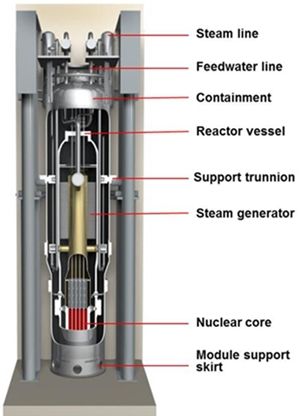
The NuScale SMR. Source: Nuclear Regulatory Commission.
The claim that a nuclear-powered torpedo could attack targets with little or no human intervention is true.
-
Although little is publicly known of China's modern heavyweight torpedo, the Yu-6, it is estimated to be comparable to Western heavyweight torpedoes, such as the U.S. Mk-48 Mod 7 Common Broadband Advanced Sonar System (CBASS) torpedo. While these weapons are "wire-guided" - i.e. operation is semi-autonomous via a thin fiber optic wire tethered to the host submarine - they are also capable of untethered, autonomous fire-and-forget operations using onboard sensors and processing.
-
Lethal autonomous weapons are already operating in the undersea domain. Modern sea mines rely on algorithmic processing to detect, identify, classify, and engage targets without human intervention.
-
If loitering for extended periods, the torpedoes would likely operate in semi-autonomous mode - i.e. maintain regular communication with human operators via satellite. Fully autonomous operations would likely be reserved for terminal homing.
While the SCMP article claims that the nuclear-powered torpedo would be conventionally armed, the Guo paper makes no specific claim with respect to the nature of the warhead.
-
Both the SCMP article and the Guo paper allude to the Russian Poseidon, downplaying that weapon's utility given its high production costs, which would enable only a relative handful to be deployed, and that it "mainly serves as a strategic weapon."
-
Though there is no mention of the type of warhead involved, presumably the torpedo would be armed with a conventional heavyweight warhead for purposes of engaging submarines or surface warships from standoff range, either directly, or indirectly if deployed in swarms of loitering underwater munitions (mobile mines).
While a nuclear-powered standard torpedo may be largely conceptual, there are currently technologies that could extend the operational range and endurance of heavyweight torpedoes and provide China with a rudimentary undersea swarming capability.
-
When it was unveiled in 2012, the range of the Atlas Elektronic SeaHake Mod 4 ER torpedo was reportedly 140 kilometers (87 miles) at speeds of 50 knots. It is electrically-powered, and uses a telescoping mast for communication and satellite navigation, and while it would not enable the range and endurance of a nuclear-powered torpedo, it would enable standoff deployment, comms/navigation, and, depending on factors such as transit range and speed, could potentially provide a short-term swarming minefield capability. There is no open source evidence indicating that China has developed a similarly long-range, high-endurance torpedo, however there are scattered reports/rumors that China is developing an electrically-powered torpedo, the Yu-9.
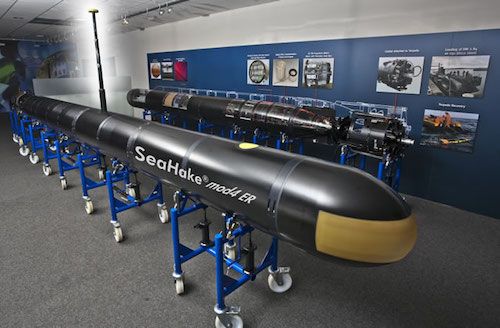
The Atlas Elektronic SeaHake Mod 4 ER -
Small nuclear reactors have been used to power spacecraft for decades. A general purpose heat source radioisotope thermoelectric generator (GPHS-RTG), which powered the Cassini orbiter, used 7.8kg of plutonium dioxide to generate 300 watts of thermoelectric power. The diameter of the generator casing is approximately 422mm, which would enable it to be integrated into a 533mm heavyweight torpedo.
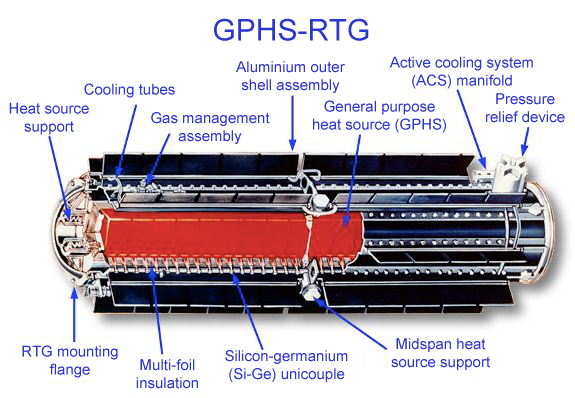
-
Blended wing underwater gliders can provide the range, endurance, and payload capacity necessary to deploy a rudimentary undersea swarm. Chinese scientists have demonstrated an increasing interest in such vehicles.
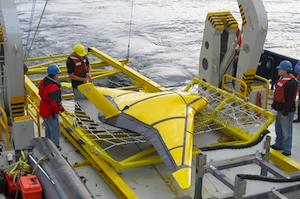
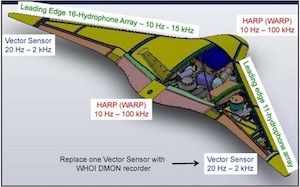
The ZRay blended wing underwater glider. -
Low energy nuclear reactions (LENR) are a potentially viable source of energy. United States government labs, as well as universities and private industry are actively involved in researching LENR. Just last month, the U.S. Advanced Research Projects Agency-Energy (ARPA-E) allocated $10 million in funding to study LENR. Some fifteen other countries are engaged in similar research, including China. (An excellent resource on LENR research can be found here.)
| OPERATIONAL CONSIDERATIONS |
Chinese strategists view undersea swarms as a logical extension (or evolution) of offensive mine warfare.
-
China has a long-standing interest in offensive mine warfare as an effective tool for sea denial. The exact size of the PLA Navy's sea mine inventory is unknown, but as of 1999, it was rumored to possess some 50,000 mines spanning 30 different variants, including contact, magnetic, acoustic, pressure, remotely controlled, and rising. (See Erickson, Goldstein, Murray, Chinese Mine Warfare: The PLA Navy's 'Assassin's Mace' Capability.)
-
With the capability to deploy semi-autonomous, mobile mines from standoff range, in waters of any depth, Chinese offensive mine warfare operations would no longer be confined to the littorals, or the seabed. (NOTE: China does possess submarine-launched mobile mines (EM-56), however these are essentially repurposed early model torpedoes that are launched from a submarine and transit to an designated area where they sink to the seabed and operate as bottom mines.)
-
Chinese strategists view mobile mines as a means to ambush enemy ships in home waters, and to contain enemy forces in port. A quote by Ma Liang in the SCMP article alludes to "strik[ing] submarines as they leave port in home waters that is difficult to reach by manned platforms."
-
Mobile minefields could be used not only to to influence enemy operations and generate strategic effects, but to attrit larger numbers of enemy ships than would be possible using bottom or moored mines.
While in theory a salvo of nuclear-powered torpedoes could "transi[t] from Shanghai to San Francisco in a matter of weeks," it is unlikely that nuclear power would be used to "drive a swarm of torpedoes across the Pacific"
-
The swarm would require regular navigational fixes in order to properly position itself prior to terminal homing. Cruising at up to 30 knots, navigational errors would compound quickly, draining the weapon's limited nuclear fuel supply to course correct.
-
Torpedoes would need to slow and surface periodically to expose a communications mast to obtain a navigational fix, making the swarm vulnerable to detection and enabling the enemy to take evasive action or employ countermeasures.
-
The swarm could receive acoustic guidance while submerged, but this would require a prepositioned network of manned vessels, surface buoys, or USVs to act as navigational beacons. These would also be vulnerable to detection, destruction, or countermeasures, and would also add a layer of operational complexity to the swarm's deployment.
The most likely CONOPS of high-endurance, long-range AUVs, such as nuclear-powered torpedoes, would involve salvo launches from standoff range by manned Chinese submarines or extra-large AUVs (XL-AUVs) operating in the Pacific ocean.
-
The AUVs could directly target U.S. carrier strike groups (CSGs) operating in the Western Pacific, strategic sealift ships transiting the Indo-Pacific theater, or strike vessels as they attempt to sortie from Pearl Harbor, San Diego, or Kitsap.
-
Alternatively, the AUVs could transit to an area of operations and establish a persistent, autonomous minefield, loitering and awaiting an attack order from human operators. This would be highly effective in blockading enemy ports, attacking warships while still in port, or denying access to key regions of waterspace via strategic chokepoints, such as the South China Sea via the Indonesian or Phillipine archipelagos, the East China Sea via the Ryukyu Islands or the Sea of Japan.
-
Although billed as standoff, long range weapons, high-endurance AUVs could also be deployed to establish long-term swarming minefields in regions of waterspace that are too deep for bottom, moored, or encapsulated torpedo mines, such as the waters off the eastern coast of Taiwan, or anywhere along the first island chain.
SCENARIO: THE MINING OF GUAM
The following scenario illustrates how China could employ long range, high endurance AUVs, such as a nuclear-powered torpedoes, against the United States.
The U.S. island territory of Guam is located approximately 3300 miles west of Hawaii, and 1500 miles east of the Phillippines. It is home to Naval Base Guam, where five Los Angeles-class attack submarines (Submarine Squadron 15) are currently homeported, and Andersen Air Force Base, a critical node for U.S. heavy strategic bomber (B-1, B-2, B-52) operations. Naval Base Guam is also a logistics and stopover hub for a wide range of U.S. and allied/partner surface and subsurface assets, including cruisers, destroyers, aircraft carriers, as well as attack (SSN), guided missile (SSGN) and ballistic missile (SSBN) submarines. Both bases are key to U.S. power projection in the Indo-Pacific region, and would be of critical importance for the United States during a sustained, high intensity conflict in the Western Pacific.
Given its strategic importance for the the United States, Guam would likely be the target of a Chinese ballistic missile attack during the opening stages of conflict. Guam's current missile defense is provided by a combination of Arleigh Burke guided missile destroyers (DDGs) and Ticonderoga-class guided missile cruisers (CGs) equipped with the Aegis Ballistic Missile Defense (BMD) system. Prepositioned mobile mines could be directed to attack these ships in advance of a missile attack, cutting off a critical means of defense. These mines could also attack ships sortieing from Guam should the United States receive advance warning of a Chinese missile attack, or while still moored inside Apra Harbor.
Deploying the Minefield
Several weeks prior to a planned offensive, China deploys three Type-039B Yuan-class submarines¹, each armed with 16 (estimated) nuclear-powered heavyweight torpedoes to engage in a two-pronged attack on Guam.² With an estimated range of 6500 to 8000 nautical miles, and an endurance of 60 days, the submarines, operating out of Daxie Dao or Luhan submarine bases, transit to a location within 1000 miles northwest of Guam, beyond the range of U.S. Navy ASW patrols, where they launch a salvo of 48 torpedoes. Assuming they transit at an average speed of 15 knots, the torpedoes arrive on station off the coast of Guam anywhere from 33 to 67 hours later, and assume a patrol which they can sustain from 104 to 123 days, surfacing periodically to obtain navigational fixes and to maintain communications via satellite with human operators.³ Should the offensive be delayed, the torpedoes would reach their max endurance, then scuttle and sink to the seabed, and the minefield could be reseeded by a future mission.⁴
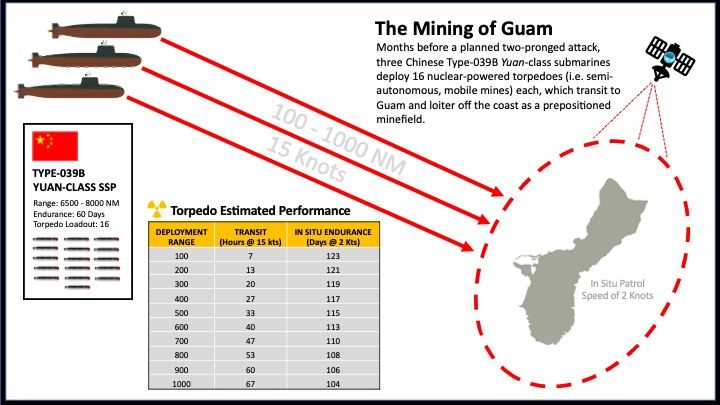
Strike on AEGIS BMD Warships
Once the attack order has been given, target and navigation data is transmitted via satellite to any surfaced torpedoes, with the data propagating throughout the swarm using acoustic communication. An initial wave of torpedoes breaks away from the minefield and transits under remaining nuclear or stored electric power toward designated targets - Aegis cruisers and destroyers operating off the coast that are charged with defending Guam against ballistic missiles. With little or no warning, the torpedoes successfully kill their targets, significantly degrading Guam's ability to defend itself against missile attacks.
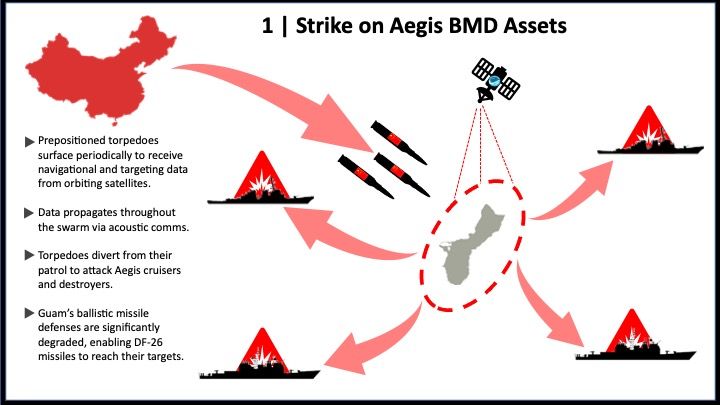
Simultaneous Attack on Naval Base Guam
As the initial wave of torpedoes dismantles Guam's BMD defense, a second wave of torpedoes receives target and navigation data for a simultaneous attack on ships and submarines moored at Naval Base Guam. The torpedoes break away from the minefield, and, using a combination of inertial navigation and AI, make their way into Apra Harbor to strike submarines moored at Polaris Point, or surface ships, such as cruisers, destroyers, tenders, strategic sealift ships, or even a CVN, moored at inner Apra Harbor. Surface ships may include additional, repurposed Aegis-equipped Ticonderoga-class cruisers that have been integrated into Guam's BMD, further degrading the island's defenses. Any remaining torpedoes continue to loiter offshore, forming a blockade to interdict reinforcements and resupply vessels, or to strike ships that have survived the initial strike and attempt to escape.
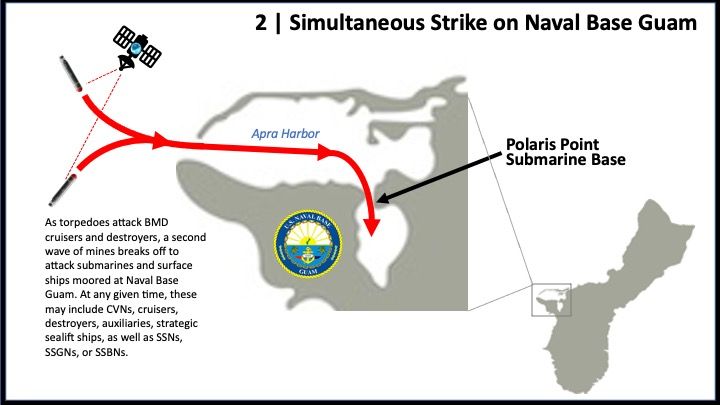
This is just one possible scenario involving Chinese use of prepositioned long-range, high-endurance torpedo-mines. Other possible missions include blockading ports, attacking submarines transiting strategic chokepoints, striking vessels inside Allied/partner ports, such as Sasebo or Yokosuka, interdicting U.S. strategic sealift or carrier strike groups, or loitering off the coast of key U.S. Pacific naval installations - Pearl Harbor, Hawaii, San Diego, California, or Kitsap, Washington - to strike ships in home waters.
Scenario Notes:
1 - China currently operates approximately 17 Type-039A/B Yuan-class SSP (air-indpendent power) submarines out of Daxie Dao and Lushun submarine bases. Given this vessel's range (which open source data indicate to be between 6500 and 8000 nautical miles, the estimated range of the Type-039B export variant, the S20), and the number of vessels available, it was chosen for this mission. Alternatively, a nuclear-powered submarine, such as the Type-091 Han-class, or the Type-093A Shang II-class, with its estimated loadout of 22 torpedoes, could also be used for this mission. However, with a total of three Hans and six Shang IIs in the PLAN inventory, with some undergoing maintenance or workups at any given time, or otherwise underway, they may be unavailable. In addition, while other classes of PLAN diesel-electric submarines could also potentially deploy the torpedo-mines, the Type-039B's AIP capability would provide greater stealth, as there is no need to snorkel and expose itself to possible detection.
2- In the absence of reliable estimates concerning the Type-039B torpedo loadout, the Type-039A loadout is used, which is estimated to be 16. It is possible that not all torpedoes would be used for the mining mission, and that space may be reserved for conventionally-powered torpedoes for self defense.
3,4 - The scenario assumes a transit speed of 15 knots, and relies on performance data derived using the Guo paper claim that a nuclear-powered torpedo could operate for 200 hours at 30 knots, or longer if operated at a lower power consumption. For simplicity, it was assumed that power generation would increase/decrease in a linear fashion - i.e. if 200 hours @ 30kts, then 400 hours at 15kts, 600 hours at 10kts, etc. Alternatively, if the torpedoes transited at a lower speed, they could be launched from a greater standoff range, and still operate in situ for an extended period of time.
CONCLUSION:
China is actively pursuing a breakthrough in energy production that would extend the operating range and endurance of AUVs in order to enable persistent, wide area operations, including undersea swarming. While it is highly unlikely that China will develop and operationalize a nuclear-powered standard torpedo within at least the next ten years, given that other forms of energy production are either currently available or under development, it is likely that China will acquire an undersea swarming capability within that time period. This will dramatically enhance the People's Liberation Army Navy (PLAN) mine warfare capability, enabling it to threaten U.S. and Allied/partner maritime forces operating in home waters, as well as in deepwater regions of the ocean, well beyond the littorals.


